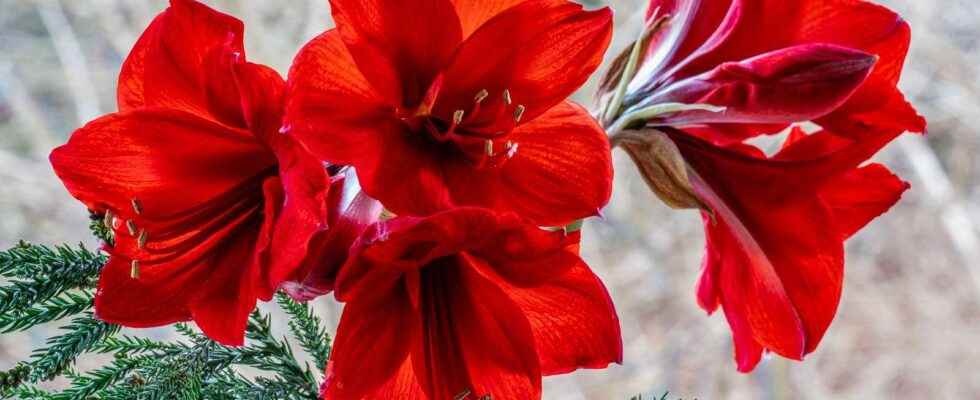This bulb with impressive flowers brings color indoors all winter. With slender green leaves, a long flower stalk and flowers of various colors, the forced amaryllis remains one of the stars of indoor plants to bloom a living room from December to early spring.
Appellations
L’amaryllis also called Hippeastrum belongs to the family Amaryllidaceae (Amaryllidacea).
Botanical description of amaryllis
Amaryllis has the particularity of having a large bulb about 20 cm in diameter. If the amaryllis were cultivated according to its natural cycle, we would benefit from its flowering in the spring. Since the majority of amaryllis bulbs are forced, their flowering occurs in winter. The bulb develops long leaves and a flower stalk with, at the end, trumpet-shaped flowers that can measure about 15 cm in diameter. With pink, red, white or salmon-coloured flowers, plain or two-coloured, passing through striped hues, you will be under the charm of this winter and spring flowering bulb.
Origins of amaryllis
This flower bulb exotic is native to South America, more particularly, to tropical regions.
Cultural requirements of amaryllis
In order to take advantage of its flowering all winter long, bring out the bulb in the fall. In October, place the bulb in a pot filled with special potting soil for flowering plants. The more you delay planting, the more you will delay flowering. Count about two months between planting and flowering. To brighten up the house Christmas, do it from October. Push the bulb into the ground and let the third protrude on the surface. Once planted, water the bulb regularly without soaking the soil. A bulb that is overwatered will rot. It is possible toadd fertilizer liquid special flowering plants, once a month. Expose the pot to the light, without Sun direct and a temperature of 20°C will suit it. Take advantage of its luminous flowering until spring.
Once flowering is complete, cut the flower stalk flush with the bulb. Without this pruning, the amaryllis may go to seed and the bulb will die out. Continue the regular supply of water and food, once or twice a month, so that the bulb renews its reserves. Put the pot in a cool room or outside, away from drafts.air and bad weather, in order to offer it a rest period of two to three months, necessary to bloom again the following year. Once the foliage is completely dry, a sign that the bulb has reconstituted its reserves, towards the end of the summer, stop watering and fertilizer. As soon as a new growth appears, you can resume watering and fertilizing.
Use of amaryllis
What could be more beautiful than an amaryllis alone in a pot that brings a touch of grace and exoticism to your interior. Gelif, the forced amaryllis bulb likes indoors. Dare to plant several bulbs to create an impressive flower arrangement. For the decorative touch, place floral stems in a vase or a soliflore.
You will also be interested
Interested in what you just read?
.
fs12
